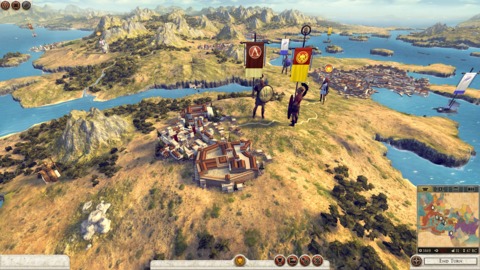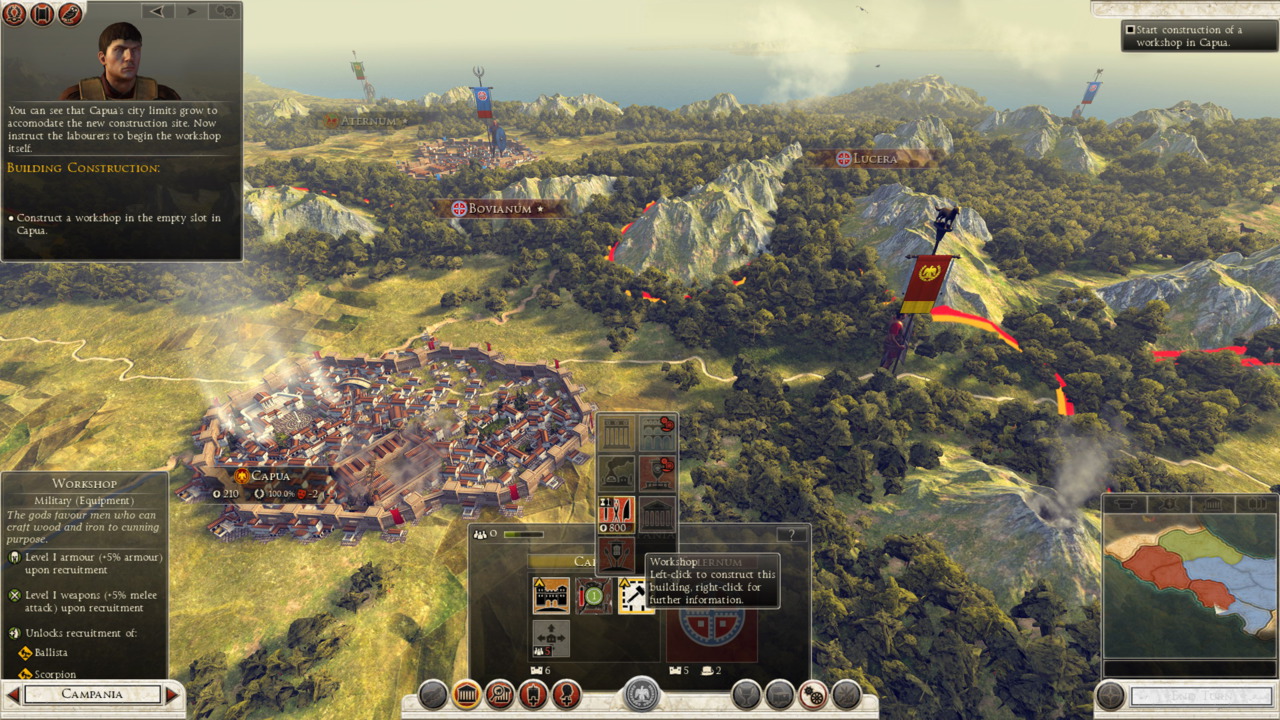The Total War series has always been about the balance between small- and large-scale conflict, and Rome II has taken that philosophy to its logical conclusion. In your quest to conquer Ancient Europe, you groom generals and warlords for command, curb the political machinations of your rivals, and launch legions of soldiers through the streets and countryside as you spread your influence. Total War: Rome II masters the tension caused by the ebb and flow of violence on both epic and personal scales; held back by a smattering of minor technical issues, it's an excellent sequel that manages to build upon the sterling reputation of its predecessors while carving out a unique place in the strategy game pantheon.
Total War's campaign mode has been dramatically expanded for Rome II. The playable countries and factions are largely the same, but the campaign map is much larger, and territory has been reorganized to reflect the differences between the barbarian and civilized cultures. These cultures play quite differently, especially on the macroscopic scale to reflect their historical distinctions. Hellenistic and Roman cultures both place a much greater emphasis on capitals and industrial output. Most of the other factions lean toward a distributed network of cities and production. In terms of play, this often means that barbarians can recruit soldiers from nearly any territory they control, and can often create much larger armies very quickly; however, they do so at a greater cost and higher upkeep.

In addition to an overhauled provincial system, there are more than a few changes to the finer points of imperial management. Public order or the satisfaction of your citizens depends heavily on the buildings you have constructed, whether or not you're engaged in any kind of war, the current tax rate, and a dozen or so other factors. There are enough potential influences on your citizens' satisfaction that it can, in fact, be difficult to keep track of, and one of Rome II's few design oversights is a UI that doesn't make everything that goes into your stats clear. This means that when your people begin to rebel, it's not always easy to find a way to keep them happy and to keep the area stable.
Where you are likely to find plenty of detail and more than enough options is in the countless other subtle additions that have been made to the Total War formula. If you have spies that have given you intel on approaching enemies, your forces can use the landscape to prepare an ambush or fortify your position and make it that much harder for an opponent to take any kind of action against your empire or your citizens. Weather can also play a role, when paired with your spies, diplomats, and champions. Eliciting information on the composition of enemy troops--namely the breakdown of cavalry and ranged units in their ranks--can help you create valuable opportunities and exploit key weaknesses.

When you do find yourself directing the movement of individual units on the battlefield, you're treated to something that is surprisingly rare in strategy games: old-style field tactics. Breaking ranks and causing panic is the name of the game here. Flanking, hitting troops with projectiles, charging, and slamming ranks with cavalry all cause panic and break the lines of regimented troop formations. Using that knowledge effectively means that you don't have to fight to the last man and that you won't need to risk the lives of your own men doing it.
Morale matters. If you're careful, it's not unreasonable to be able to break three of four enemy units with only one of yours, without suffering heavy casualties, and if that same unit has a general in its ranks, it can take on eight or more. The game's AI can often make some pretty strange decisions on troop positioning and movements, especially if you're playing on the lower difficulties. That said, poor planning, haphazard attacks, and unfocused assaults will only spell death for your men.
Their loss, should you pick your formations and tactics incorrectly, is made more impactful by some spectacular sound design and great attention to visual detail. Unless you choose to reduce onscreen unit sizes in the graphical settings, every single person is visible. Each one dies or lives based on where and how they are hit with arrows, or how they take hits from the enemy. The incredible number of people and actions onscreen at any given time is staggering. It's no wonder, then, that during the larger battles even with a computer that is far above the recommended stats, the action still chugs along.

Camera angles can be problematic at times as well. During those same large battles, especially if they take place in a city, it can be difficult to gather the information you need. Thankfully, there's a tactical map that shows the entire field. From there, you can pause the game, and issue and queue up orders, before picking everything back up and watching how it all plays out. That said, not being able to easily switch between a bird's-eye view and the more personal one diminishes one of Rome II's biggest strengths.
Sadly, there are a handful of other visual bugs that plague an otherwise exceptionally rendered game. Texture pop-in, for example, can be pretty common. In some rare cases, the developer's placeholder is loaded instead and you see a red and blue patchwork marked with the word "Texture." It's not enough to detract from the game, but it's still common enough that it presents a real problem, especially when combined with the game's occasional instability. Every now and then a menu or dialogue box fails to load, locking you into a screen from which there is no escape. It's enough that closing the game and losing a bit of progress is the only option.

These technical problems wouldn’t be quite so disappointing if Rome II weren't so adept at providing moments of true brilliance. In some cases, due to poor tactics or sheer bad luck, you can begin a battle with a huge advantage and still lose all but a few soldiers. Some of the game’s most exhilarating battles are decided by what you manage with only one or two units; if you’re left with only your general and his bodyguards, you might actually stand a chance of survival. Coming back from the brink of loss and capturing a capital or defending a strategically important point is one of the most satisfying experiences in Rome II.
The catharsis of seeing well-executed plans succeed is reinforced by the sheer variety of battle types Rome II offers, each with an independent set of win conditions and unit considerations. Forested areas, cities, rivers and open fields require different approaches and support certain unit compositions better than others. These battles often reflect the macroscopic conditions on the world map. Sieges, ambushes and river battles are based heavily in the geography of the land, meaning that exploration takes on a unique level of importance and encourages aggressive, militaristic play.

To truly test your skills, you’ll certainly need to take your experience online. Rome II supports both one-off battles as well as cooperative and competitive campaign modes. While the tactical AI is competent enough, some of the finer points of diplomacy and non-combat play are best experienced when facing another person. The rock-paper-scissors relationship of spies, champions and dignitaries takes on a whole new importance as well, often leading to a kind of espionage brinksmanship.
Technical issues aside, the upgrades to Rome II have helped blur the lines between tactics and strategy, creating a powerful, engaging drama that works well on every scale. It really is a fantastic sequel and a great addition to an already remarkable series. For millennia, war has altered the face of the world in which we live. Men could earn their freedom, families could rise to or fall from power, and nations could leave their mark on history. It serves as the dramatic fuel for some of humanity's greatest stories, both fictional and real. Total War: Rome II brings that drama back in a great way.